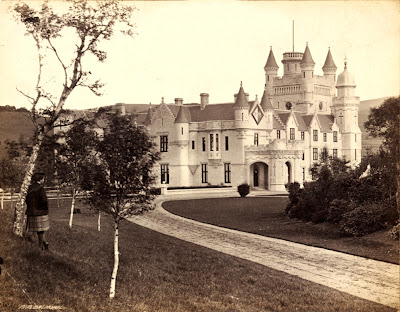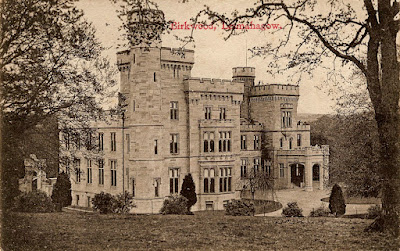 |
| Balmoral Castle, Royal Deeside, Aberdeenshire, Scotland, 1897 [From my own collection] |
During Queen Victoria's long reign she made use a number of royal residences, primarily Windsor Castle in Berkshire, Buckingham Palace in London, Osborne House on the Isle of Wight, Holyrood House in Edinburgh, and Balmoral Castle in the Scottish Highlands.
This series primarily features 'behind the scenes' period images from Queen Victoria's Private Apartments which attempt to portray something of Her Majesty's personal world away from the public gaze. Actual original extant photographs or images of Queen Victoria when resident at each Royal residence are also featured. Our second blog in this series features images taken at Queen Victoria's beloved Scottish Highland retreat of Balmoral Castle.
Much of the Castle was decorated in Royal tartan with pine coloured woodwork and Victorian patterned wallpapers. Subsequent redecoration has replaced the printed wallpaper and some of the tartan décor with a blend of modern contemporary styles although tartan is appropriately still evident.
 |
| Balmoral Castle, Royal Deeside. Photochrome Print, c.1900 |
 |
| Queen Victoria on "Fyvie" with her Highland Servant John Brown, taken at Balmoral Castle by George Washington Wilson, Jun 1863 |
 |
| Queen Victoria's Drawing Room, 1857. The whole house was decorated in royal tartans. |
 |
| Queen Victoria on a pony at Balmoral Castle with John Brown holding the reigns, Taken by "W&D Downey", June 1868 |
 |
| An early photographic view of Queen Victoria's Drawing Room, c.1880's? The patterned wallpaper has not yet been put up. |
 |
| Queen Victoria with "Sharp", the Border Collie, taken at Balmoral Castle, 1867 |
 |
| Queen Victoria's Drawing Room, taken 1890's. The patterned wallpaper is now evident. |
 |
| A lithograph of Queen Victoria receiving Lieutenant-General Sir Garnet J. Wolseley G.C.B. G.C.M.G. in the Drawing Room upon his return from Egypt. |
 |
| Queen Victoria's Drawing Room, circa 1890's |
 |
| Queen Victoria's Bedroom, 1850's |
 |
| Queen Victoria's Bedroom, circa 1880's-90's |
 |
| Queen Victoria in her carriage outside the main entrance to Balmoral Castle. |
 |
| Queen Victoria's Dressing Room. A Watercolour by James Roberts, 1857 |
 |
Abdul Karim ('The Munshi') waiting on Queen Victoria as
she attends to her red boxes at Balmoral Castle, 1897
Note the collie dog by her side.
|
 |
| The Dining Room, taken 1890's |
Two extremely rare cine films of Queen Victoria, the first
taken at Balmoral Castle in September 1896 (refer below
for names) and the second shows the Queen riding down
Pall Mall London in a carriage during her Jubilee
Celebrations of 1897.
Queen Victoria described "moving pictures" as "a very wonderful process, representing people, their movements and actions, as if they were alive." She viewed the footage taken at Balmoral Castle with delight, requesting a second viewing which was unfortunately not possible due to the difficulties of quickly rewinding and re-threading the film in the projector.
 |
| A still from the "animated pictures", taken in September 1896 |
Czar Nicholas II stands behind Queen Victoria sitting in her pony carriage. Next to the Queen are her Granddaughters, the Princess Louise of Wales, The Czarina (Princess Alix of Hesse), her Daughter in Law Princess Louise of Prussia, and the Duchess's Daughter Princess Margaret of Connaught, Princess Patricia of Connaught is in foreground seated on the pony carriage step holding a dog.
 |
| The Lower Corridor and Staircase, a watercolour by James Roberts, 1857 |
 |
| The Household Drawing Room, 1895 (used by Ladies in Waiting and other member of The Queen's Personal Staff) |
 |
| The Entrance Hall, hung with stag heads shot by Prince Albert, taken 1890's. |
 |
| Queen Victoria with [left to right] Alexandra, Tsarina of Russia holding her Daughter Grand Duchess Tatiana; Tsar Nicholar II of Russia; and Edward Prince of Wales. Taken September 1896 |
 |
| Balmoral Castle Ballroom, 1890's The annual Gillies' Ball would normally be held here. |
 |
| A large tent decorated for the Gillies' Ball in 1857 |
- "Life of Queen Victoria", T Nelson & Sons, London, 1897 (from my personal collection).
- Various written and Internet sources.
- All other images appear to be in the public domain however if copyright has been infringed please advise me.
- Various written and Internet sources.
- All other images appear to be in the public domain however if copyright has been infringed please advise me.
- Images are only from my own personal collection where specifically indicated. These may be freely copied providing a link is given back to this page.
























